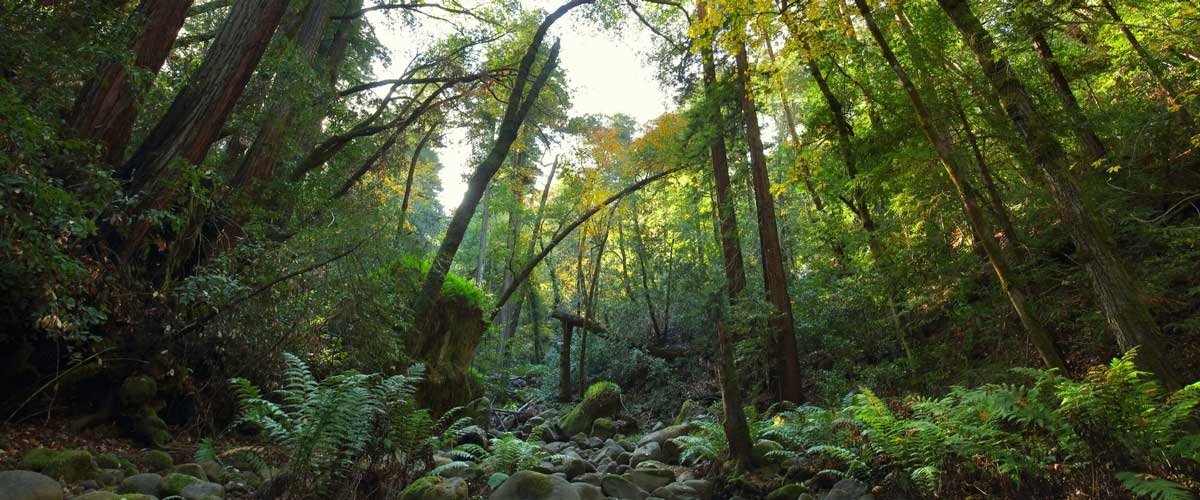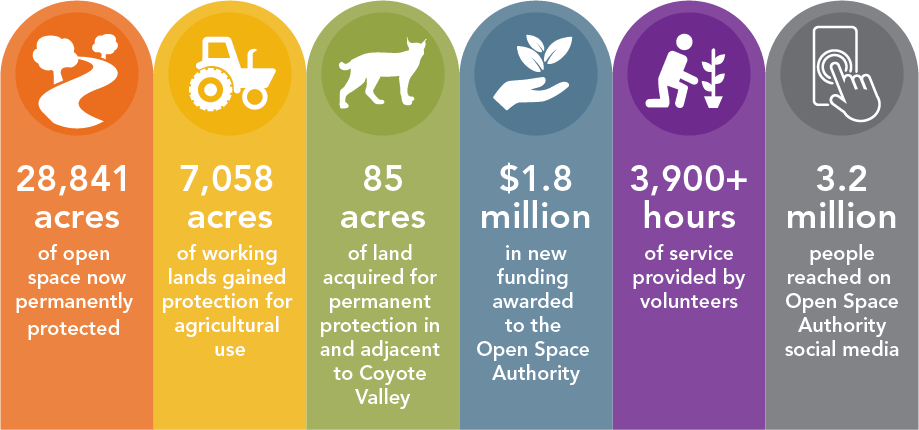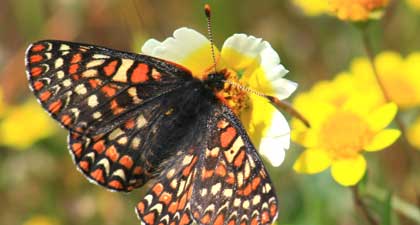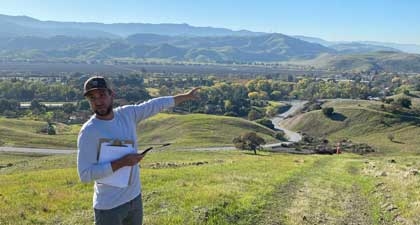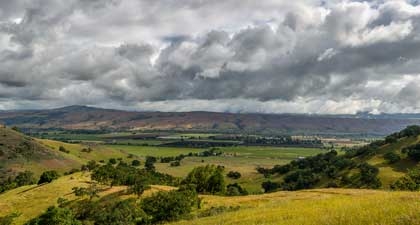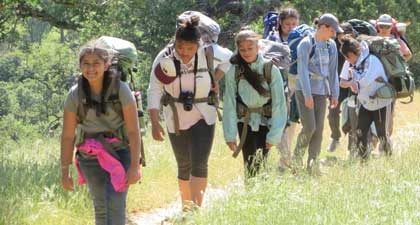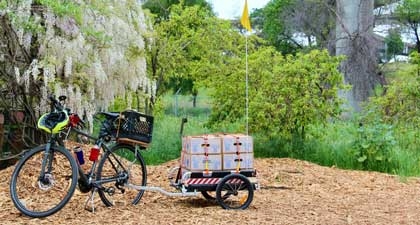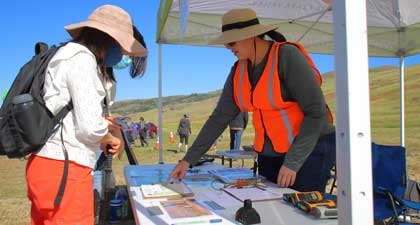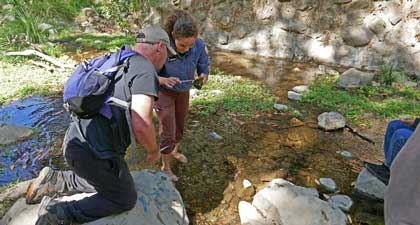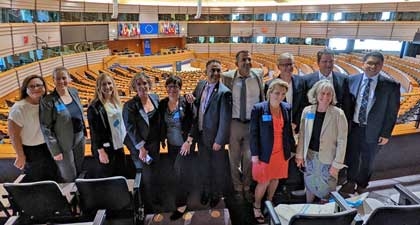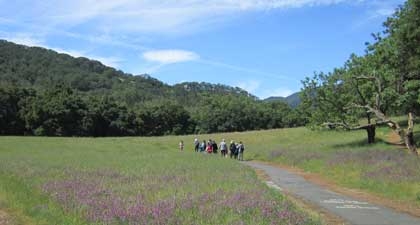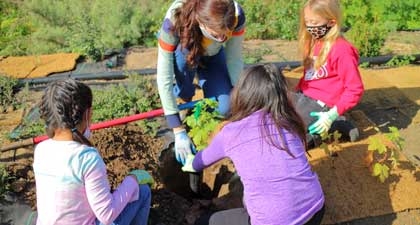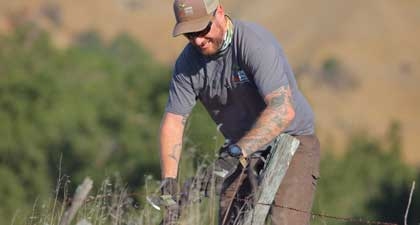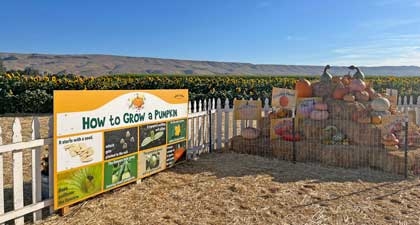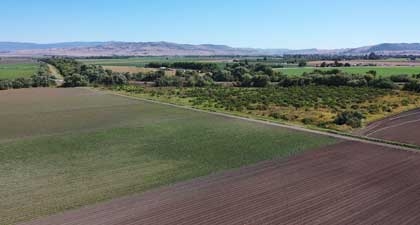The Open Space Authority’s land stewardship efforts expanded in 2022, building on the agency’s expertise to restore habitat, protect wildlife, promote climate resilience, and support the region’s watersheds. With a diversity of funding sources, both public and private, the Open Space Authority is advancing the restoration of important wetland and riparian corridors and supporting critical biodiversity through the vibrant ecosystems of the Santa Clara Valley.
In August, the Open Space Authority developed a new Natural Resources Department and hired Aaron Hébert as the first Natural Resources Manager, building upon the agency’s efforts to maintain and support the rich ecology of the lands the Open Space Authority manages.
The Natural Resources Department and the Field Operations Department continue making progress on a variety of long-term restoration and stewardship projects.
Restoration in Coyote Valley
Fisher Creek Riparian Habitat Restoration Project
The Open Space Authority made strides in the ongoing Fisher Creek Riparian Restoration project. Fisher’s Bend, a section of Fisher Creek located in Coyote Valley, is a wildlife corridor with critical riparian habitat (or habitat alongside a river). Over the years, the neglected land slowly degraded until
Peninsula Open Space Trust purchased it in 2017 (and it will be transferred to the Open Space Authority in the future). The Fisher Creek Riparian Restoration project, spread across different properties and supported with multiple funding sources, began in 2020 with the goal of restoring riparian habitat and to creating a buffer between Fisher Creek and agricultural operations.
In 2022, the Open Space Authority and
Point Blue Conservation Science went out to Fisher’s Bend as part of Point Blue’s Students and Teachers Restoring a Watershed (STRAW) program, continuing their critical partnership. Together, they
welcomed roughly 70 second graders from Bradley Elementary School to plant over 150 native plants along the critical riparian corridor.
The project will involve planting more than 1,500 native plants in the area to provide a variety of benefits, both for wildlife and to increase the climate resilience of the area. Some of the plants will provide more cover along the creek, as studies have shown that animals like bobcats prefer traveling through areas with sufficient cover to keep them hidden.
After the plantings earlier in the year, field staff have been regularly monitoring and maintaining the area and preparing it for the upcoming years of the project, which will include installation of interpretive signage, additional school plantings, and monitoring and management.
In addition, the Fisher Creek Riparian Habitat Restoration Project continues further south on Palm Avenue on a 93-acre property in Mid-Coyote Valley, acquired by the Peninsula Open Space Trust (POST) in 2020 and upstream of Fisher Creek. In 2022, the Authority installed new fencing and a water tank, laying the groundwork for future restoration work. For the next phase, beginning in 2023, the Authority will work with Point Blue’s STRAW program to plant oak trees for acorns, plant willow tree from cuttings, and tie it in with an upcoming monarch butterfly habitat restoration project (see below).
- FUNDER: $150,000 from Bonneville Environmental Foundation; $440,000 from Supplemental Environmental Project (SEP) from the Regional Water Quality Control Board of the San Francisco Bay Region, $250,000/$247,360 from National Fish and Wildlife Foundation (NFWF)
Monarch Habitat Restoration Project
The Natural Resource Department also kicked off a Monarch Habitat Restoration Project on the same 93-acre Palm Avenue property. In 2022, field staff installed a wildlife-friendly fence to protect the creek from cattle and a new irrigation system to support future riparian and monarch-friendly plantings.
- FUNDER: $250,000 to POST from Tides Foundation
Spreckels Wetland Cleanup and Enhancement Project
The Open Space Authority continued work on the
Spreckles Wetland Cleanup and Enhancement Project, which began in 2021. Many years ago, a culvert was installed in the large wetland below Spreckels Hill to drain the water from the wetland into Fisher Creek. The goal of this project is to modify the culvert opening to allow more water to stay in the wetland during dry conditions, helping to restore ecosystem services such as groundwater recharge, flood buffer, improving habitat for wildlife such as migratory birds, providing more consistent moisture, and helping to remove invasive species that outcompete native plants and limit wetland productivity and vegetation growth. It also involves removing litter scattered throughout this important habitat site.
Last year involved planning and permitting for the restoration work in in 2023, as well as a cultural resource assessment.
- FUNDER: $172,000 from Bonneville Environmental Foundation
Burrowing Owl Reserve
In November of 2022, the Open Space Authority, in partnership with the Peninsula Open Space Trust and the Valley Habitat Agency (VHA), established a 100-acre burrowing owl preserve in Coyote Valley, where VHA will be introducing more breeding burrowing owls to the habitat. They plan to introduce the owls to the landscape next year. Dave Tharp, the Authority’s Equipment Mechanics Operator, worked with Talon Environmental to install artificial nest boxes to help give the relocated owls the best start: as the land recovers from agricultural use, ground squirrel activity will establish a network of burrows that previously would get tilled under every year, and these burrows will provide habitat for more owls.
- FUNDER: Valley Habitat Agency (VHA)
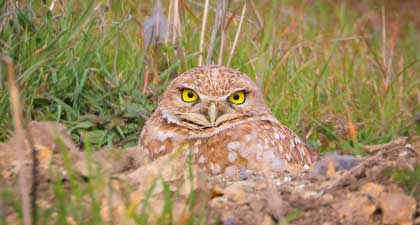
Restoration at Máyyan 'Ooyákma – Coyote Ridge
Wildlife Friendly Fencing
With the goal of enhancing wildlife movement, preventing fence-related injury, and improving conservation grazing management throughout the landscape, the Open Space Authority removed almost seven miles of five-strand barbed wire and chain link fencing and installed
over eight miles of wildlife-friendly fencing in 2022.
Wildlife-friendly fences have a smooth top and bottom, unlike barbed wire, which can harm wildlife that try to pass over the top or underneath. The bottom of the fence is also higher off the ground, unlike chain link, which is completely impermeable and prevents the crossing of wildlife altogether. This contains cattle, while supporting deer, coyote, bobcats, mountain lions, and other animals that depend on their ability to travel around to find food, water, and shelter.
“At Coyote Ridge, specifically, cattle grazing is an important part of maintaining and restoration Bay checkerspot butterfly habitat, as well as the health of serpentine and endemic species,” Hébert notes. “We are using fencing to optimize these efforts in a minimally invasive way.”
Well Installation
In 2022 the Open Space Authority also installed a well at Máyyan 'Ooyákma – Coyote Ridge to help with the long-term management of the landscape. A natural pond is nestled in Coyote Ridge, which supports a variety of native plant and animal species. To preserve the habitat this pond provides, the Open Space Authority installed a well as an alternate water source for cattle on the property. This well will help the Open Space Authority maintain sustainable conservation grazing practices to manage land and reduce fire risk, while supporting the unique and vibrant ecosystem at Coyote Ridge.
- FUNDER: $1M from US Bureau of Reclamation and US Fish and Wildlife Service (for grazing)
Restoration at Sierra Vista
In 2022, the Open Space Authority continued restoration of the
Furtado Barn Restoration Area at Sierra Vista Open Space Preserve by installing 1,400 plants donated by the Xerces Society.
Staff from every department of the Open Space Authority, as well as dozens of volunteers (see more below), participated in 5 events hosted by the Natural Resources Department to install the donated plants, which will be irrigated for the next year until they have fully established themselves, as transplanting can be stressful for them.
The Natural Resources Department dispersed native plant seeds to create an even gradient of native plants, promoting the habitat’s biodiversity and more robustly supporting the species relying on this ecosystem.
In addition, to better protect the plants, field staff will install deer fencing to protect the plants until they are large enough to withstand deer browsing.
- FUNDER: 1400 Plants from Xerces Society; Santa Clara Valley Open Space Authority
Fuels Management Program
While wildfires can be harmful for ecosystems, it hasn’t always been this way, and fire can be beneficial. For millennia, many Indigenous Peoples have used
controlled burns as a form of land management. Smaller, cooler, controlled fires have a myriad of benefits for landscapes. Fire removes dead plant matter, controls the growth of invasive species, provides native species access to sunlight, and nourishes the soil.
Though California ecosystems are adapted to fire, the frequency and heat at which modern wildfires burn surpasses native adaptations. Fires that burn as hot as they have been change the composition of local flora and put the natural ecosystem at risk. Minimizing the intensity of these fires and lowering the frequency of these high-intensity burns, is critical to protect local landscapes and nearby communities. In 2022, the Open Space Authority continued the Fuels Management Program to do the agency’s part managing wildfire risk.
This program assesses fire fuel risk (or areas that may start or spread wildfire) on Authority-managed lands, as well as the areas where management and fuel reduction must be prioritized. Fire fuel reduction involves a variety of approaches including strategic conservation grazing, invasive species management, and promotion of healthy native biodiversity.
“It’s about creating wildfire resiliency in our landscapes for the benefit of habitats and people,” says Hébert. “We have a variety of goals – fuel reduction, native species promotion, and habitat restoration. The key to the integrated approach is finding the overlap of where we can meet them all.”
In 2022,
the Open Space Authority worked diligently to identify areas at highest risk of wildfire. These areas can be determined in multiple ways – areas where open space transitions into developed land are particularly at risk, in addition to locations with a buildup of dead plant matter, or with plants that burn easily. With the help of a GIS mapping firm, the Open Space Authority can map past ignition sources, burn areas, and vegetation communities to extrapolate areas of highest risk using data-informed models. This can also determine areas that need the most protection (where fire can cause the most damage to people and natural resources), and then identify projects in such areas that reduce fuel load. The Open Space Authority is not alone among land managers navigating the challenges of a drying climate and increased wildfire risk. Groups like the Santa Cruz Mountains Stewardship Network and the Santa Clara County Fire Safe Council have created their own tools and collaborative frameworks to address the challenge of this regional problem at a regional level. The Open Space Authority works with these groups and others to integrate into local, County, and State efforts to manage wildfire.
Invasive species management
The Open Space Authority uses the Integrated Pest Management framework to guide how the agency manages pests to limit the risks and impacts to our preserve visitors, staff, and the lands and facilities.
The comprehensive approach of this program involves correctly identifying the species, monitoring and assessing where the pests are located and how abundant they are, setting thresholds for targeted control, assessing site conditions to identify appropriate control treatments, using the least harmful suite of control methods, and preventing pest problems by detecting new occurrences early and treating them quickly.
In 2022, the Open Space Authority expanded mapping and tracking capacity by increasing the use of CalFlora and has been leveraging the help of volunteers to control invasive species populations. The agency also began piloting the
Early Detection, Rapid Response program to address invasive plants when the populations remain small to improve the likelihood of successfully eradicating unwanted plants and using cost-effective treatments.
Currently, the pilot Early Detection, Rapid Response list includes approximately 18 top priority species that are new to the region or under surveillance for introduction to the area. These species are true early detection targets which will likely be eradication targets, if found during on the ground surveys. Some may prove more common than anticipated, in which case control or containment efforts can be considered. David Mauk, Natural Resource Technician, is focusing on places of the highest risk -- preserves open to the public, conservation areas with extensive road systems, regions with high natural resource value/critical habitat, and areas with lots of Open Space Authority activity.
Volunteer program
The
Volunteer program plays a critical role the Open Space Authority’s model of land stewardship. Land Stewards made great strides in 2022 in tackling priorities for invasive species removal, through maintenance and clean-up projects and through restorative plantings. By the end of 2022, their efforts contributed over 800 hours of labor towards over 30 different projects!
Volunteers removed nearly 4,000 square feet of invasive species from the Furtado Barn Restoration Area, transforming the landscape and leading the way to the introduction of beneficial native pollinator plants, thanks also to a grant from the Xerces Society. “I cannot wait to see how this place will continue to transform with more care from our staff and volunteer community,” says Kat Hill, Volunteer Program Coordinator at the Open Space Authority.
Trail patrol volunteers completed over 230 different patrols, on bike, foot and horse, in our three main preserves-- welcoming visitors to our preserves, reporting trail conditions and wildlife and supporting Field Operations. Thank you also to motivated Trail Masters who facilitated volunteer trainings for trail patrol throughout the year!
Community Engagement is also an important part of the Volunteer Program. In 2022, the Open Space Authority received a number of invitations to share our agency’s work, resources, and passion with an energized public at community events. After a nearly 2.5 year absence, the team was happy to be back in these event spaces connecting with the public. A key to this success was overwhelming support from volunteers to represent the Open Space Authority at a myriad of community events.
Preserve Stewards, who help field staff during busy spring hours and provide support for large-scale events, contributed over 600 hours towards facilitating public enjoyment of our preserves. This included Máyyan 'Ooyákma – Coyote Ridge and Diablo Foothills Open Access and Earth Week. They also served the public with information booths in staging areas and engaged preserve visitors during the Open Space Authority's one-way trails survey.
“The story that ties all of our public engagement efforts together is the positive and capable response of our volunteers,” says Gavin Comstock, Volunteer Program Administrator. “We are proud of the opportunities we can offer the public through diverse educational programming and stewardship projects. And the responsivity and support of our volunteers is an incredible tool to help us open the gate for as many interested people to join us as possible.”
